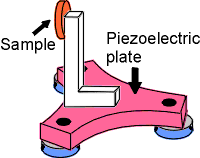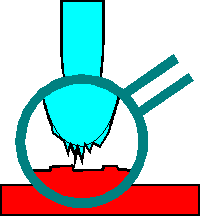
Piezoelectric Effect: Applying stress on piezo materials causes electric
polarisation
Reverse Piezoelectric Effect: An electric field applied to a piezo material
causes mechanical strain
Piezocrystals: quartz, BaTiO3
Piezoceramics: Pb(Ti,Zr)O3 (PZT)




 .
.| EBL#1(Stavely Sensors) | |
| d31=-1.27Å/V (tranversal) | d33=2.95Å/V (longitudial) |
|
The tip is controlled by three orthogonal piezo bars |

|
 |
A Bimorph is made out of two thin plates of piezocrystals which are stacked in
such a way that a voltage applied on the plates causes stress of opposite sign
which generates a deflection
(principle is similar to the bimetallic thermometer). By combining several bimorphs a three-dimensional scanner can be constructed. |
| A cylinder, made out of piezoceramics, is covered inside and outside with metal, which acts as electrodes. The outer electrode is divided into four sectors. A motion in z-direction (along the longitudinal axis) can be achieved by applying a voltage between the inner and the outer electrode. A deflection in xy-direction is generated by a different bias voltage applied to the two opposite electrodes. |
 |
| The tip approaches the sample with the help of springs, demagnifier and microscrews. |
 |
 |
The sample is mounted on a piezoelectric plate with three electrically isolated feet, which electrostatically can be attached to a ground plate. Thus by expanding and contracting the piezoelctric plate and clamping and detaching the feet the louse can move step by step towards the tip. |
| The Beetle consists of a plate with three piezoelectric tubes, standing on a cylindric ramp. The sample is mounted in the middle of the ramp whereas the tip with the fine positioner is mounted on the plate. By applying a voltage on the piezoelectric feet, the plate is rotated. Reducing the voltage quickly causes the feet to slip on the ramp due to the inertia of the plate. Thus the tip can be moved towards the sample or away (stick/slip motion). |

|

 |
Regarding the transfer function (ratio of amplitudes) of a damped harmonic oscillator with a sinusodial external force, it is clear that the resonant freqency must be much lower than the external frequency to be eliminated. |
Damping can be done by
|
| The tip is the trickiest part in the STM experiment. It needs a small curvature to resolve coarse structures. |
 |
 |
For atomic resoltion a minitip with a one atomic end is necessary. |
|
The tungsten wire is put into a solution of NaOH and kept on a positve
potential towards a counter electrode. The etching process takes place
predominately on the surface of the solution. When the neck is thin enough
the wire fractures due to its weight. Thus actually two tips are produced.
The tip has to be cleaned with deionized water and pure ethanol or methanol. Most often the tip is covered with an oxide layer and contaminations from the etchant and is also not sharp enough. Thus other tratments to the tip, like annealing or field evapouration are necessary. |
 |